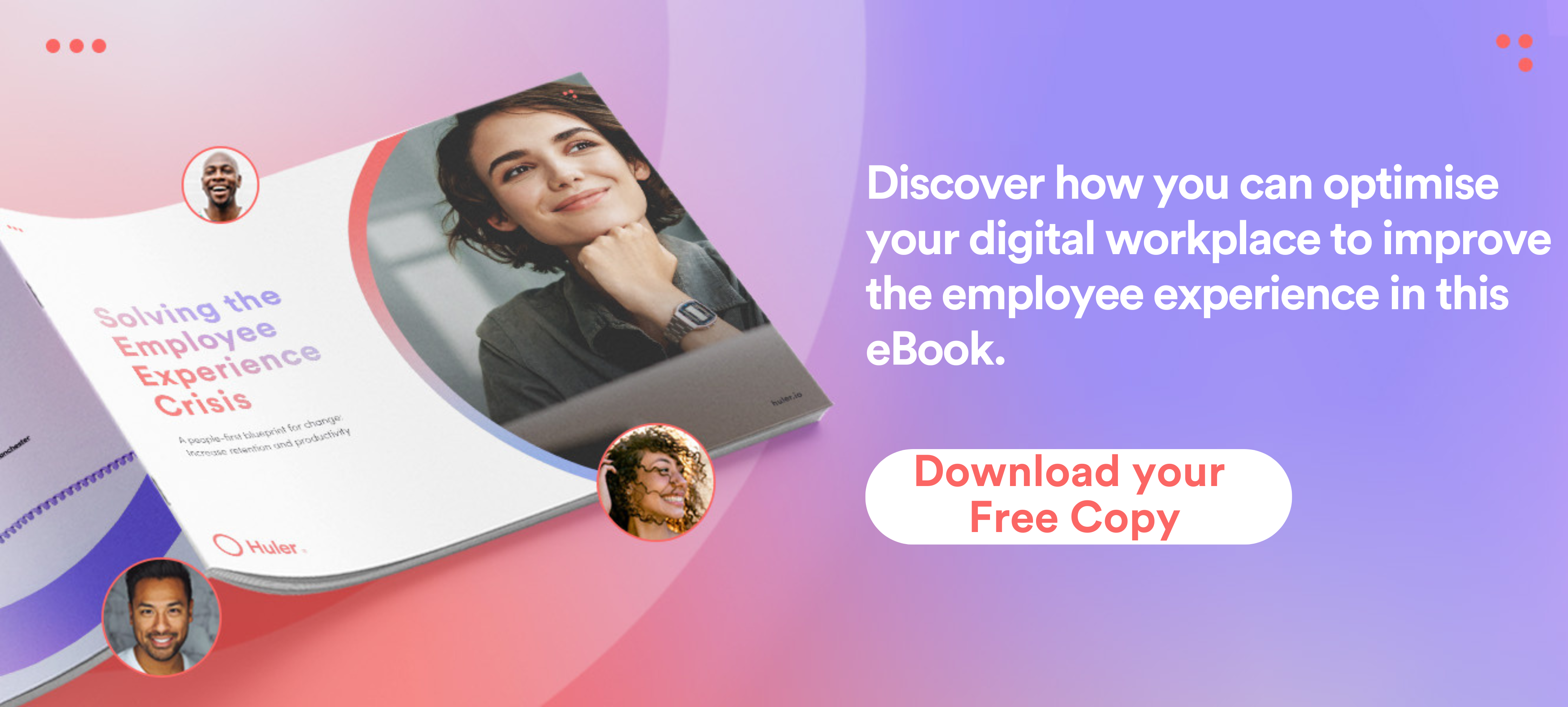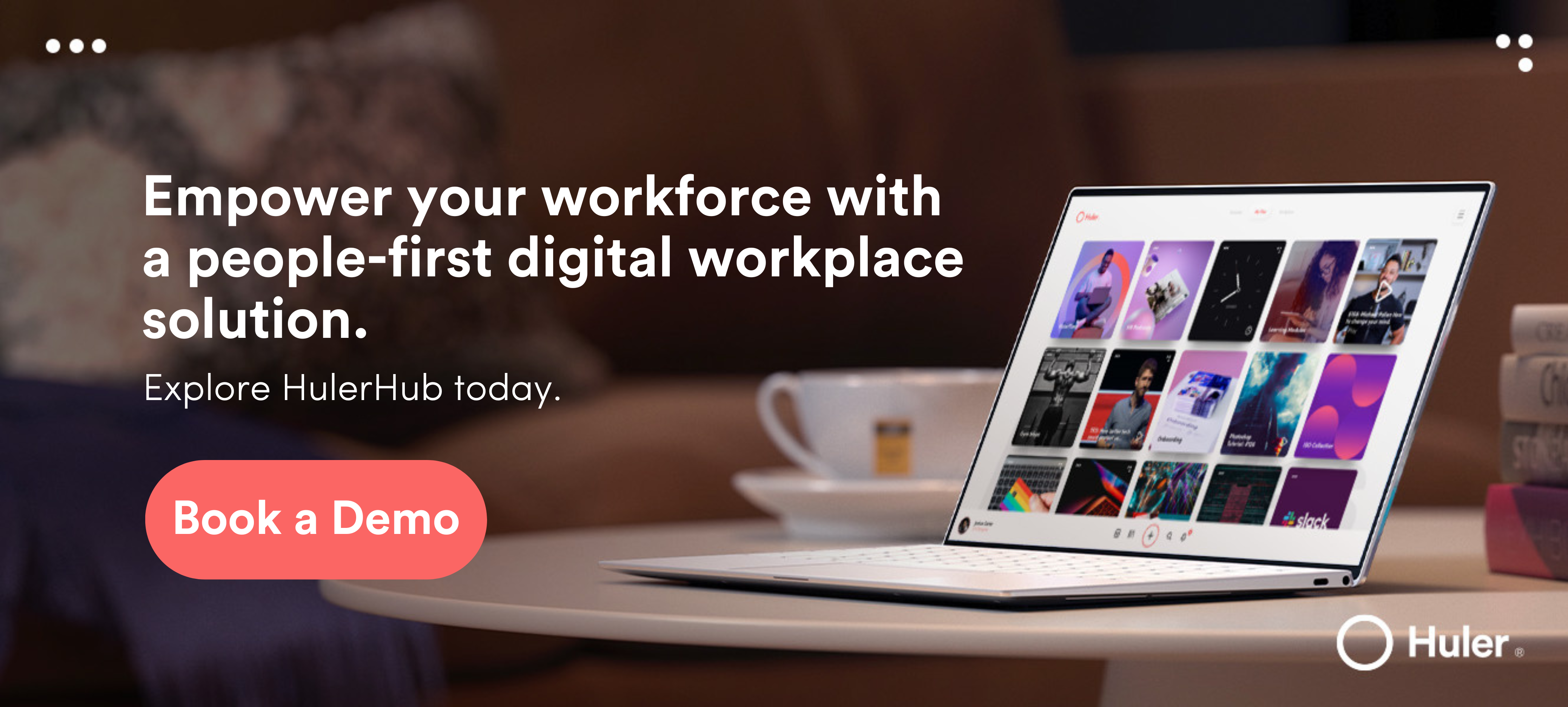Before the pandemic, the move from physical-only workplaces to hybrid and remote working might’ve seemed impossible. But as companies who have embraced the change now understand, not only is it possible, it’s also desirable — if done right.
And hybrid working is here to stay. Why? Because people like it. The proportion of people working hybrid rose from 13% in February to 24% in May 2022. And 78% of people reported a better work-life balance, with 52% reporting that they completed work quicker.¹
So how can companies get hybrid working right? By creating a people-first culture. This means prioritising employees by listening and understanding their needs, and actively creating a working environment based on this. By truly embracing the change to hybrid working and creating an employee-driven digital workplace, your people will feel organised, connected and productive, benefitting employees and employers alike.
Let’s explore the 4 key steps to building a people-first culture.
Suggested reading: If you’d like to know more about creating a positive employee experience in the age of hybrid working, check out our free eBook — Solving the Employee Experience Crisis.
Step 1 – Embrace Hybrid Working
Hybrid work is no longer just a temporary solution to the pandemic; it’s an integral part of what employees are looking for in new jobs, with a near 31,000% rise in people searching for “hybrid working jobs” between 2020 and 2022.² In fact, according to Accenture, 83% of workers surveyed said they prefer a hybrid model.³
But how a hybrid workplace is implemented can be more important than choosing to implement one. Using direct messaging and video conferencing tools like Slack or Microsoft Teams is a start, but it doesn’t suddenly turn the physical office into a digital one.
People enjoy the collaboration, immediacy and comradery of a physical office. Keeping these elements within your digital workplace is key to creating a people-first workplace. If these elements are lost, employees would miss out on a vital part of their work culture and may find work less meaningful.
The Benefits of Embracing Hybrid Working
In embracing hybrid working, you’re embracing something that many employees want. It’s a people-first decision, which can positively impact employee experience.
By improving how an employee feels about their work, you can positively impact employee engagement: a study by Gallup found a 59% reduction in employee turnover within teams who were engaged.⁴ And hybrid workers tend to be the most engaged: data from Quantum Workplace shows that 81% of hybrid employees feel engaged with their work, compared with 78% of fully remote workers and 72% of on-site employees.⁵
Taking decisions that help your employees also help your business. Not only are engaged employees more productive,⁶ with lower turnover rates, when your employees are invested in your business and your products, they are more likely to create better experiences for customers. According to one study, 79% of companies with engaged employees provided a better customer experience than those without.⁷
There are many benefits to a digital workplace, but there can also be downsides if it’s not done right — specifically, if it’s not created with people-first strategies in mind. For example, one study found that 80% of leaders reported that setting up hybrid workplaces was exhausting for employees.⁸
Moving back and forth between two (or more) workplaces — the office, at home, or whenever employees choose to work — can be an inconsistent experience, which may lead to people potentially feeling displaced. It’s important that wherever they’re working, a digital workplace provides a shared and positive employee experience.
Step 2 – Invest In Digital Workplaces
The office is no longer an employees’ sole place of work. With hybrid working, a new, equally important workplace is added: the digital one.
So it’s vital to take them both into equal consideration.
A physical office space affects the work ethic of employees through things like desk layouts, separated work areas and even the lunch areas.⁹ When working remotely, the same considerations and thinking applies.
Your employees will spend their entire day in the digital workplace, and will need to organise tasks and collaborate with co-workers — just like in a physical space. Here are the key areas to look out for in your digital workplace.
- Provide access to critical information: With offices historically being most employees’ only workplace, that was where they could access almost everything they needed. Moving to hybrid, employees should be able to find these things in their digital workplace, too. This means integration of calendar systems, any meeting booking systems you might have, access to company briefs and guidelines as well as applications and training resources
- Make your system navigable: In the office, if employees want to find something, they can simply ask colleagues questions face-to-face, easily navigating to and accessing the information they need. So your information should be easy to find through a simple, navigable digital workplace.
- Enable collaboration: For the same reason that critical information needs to be signposted and accessible, communication and collaboration with co-workers is paramount. Information should be easily shared, distributed and circulated with others — including with new starters before they begin.
- Provide an aesthetic: Traditional intranets, the precursor to digital workspaces, were designed primarily for functionality, forgoing aesthetics and customisation. Now, however, we’re used to using platforms that are intuitive, personalised and aesthetically pleasing. So your digital workspace should embody these things too for maximum engagement. And don’t overlook an aesthetic that reflects your brand and culture. The look and feel of your digital platform ties all the functions of the workplace together into a consistent employee experience. Employees should have the power to customise their workplace while retaining company style.
The Benefits of Investing In Digital Workplaces
Integrating everything from a physical workplace into a digital workplace might seem difficult. But if you use the right platform, it shouldn’t be. Using a people-first employee experience platform can bring various benefits:
- Increased productivity: An effective digital workplace provides quick access to the right resources in both remote and in-office environments.
- Improved collaboration: Communication within a smooth digital workplace enables people to connect from anywhere through tools that simplify the ways in which they collaborate and share information.
- Increased employee retention: Easy access to digital tools simplifies the onboarding and training processes, and creates a better employee experience, improving retention.
- Reduced costs all round: Embracing hybrid working can reduce office overheads and employee costs, helping you deliver better outcomes for less, and/or redeploy saved costs elsewhere.
Enhanced Flexibility and Control
Perhaps the most important thing investing in digital workspaces can deliver is increased flexibility for employers. According to EY, 9 out of 10 employees want flexibility in both when and where they work, with 54% likely to quite if they aren’t offered the flexibility they want.¹⁰ Employees’ ability to choose when and from where they work, rather than having mandated days in the office, can help improve their employee experience.
Why? Because flexibility is important because it affords people greater control over their lives, both in work and outside it. It can help employees feel supported by your company, both in work and out, improving their employee experience. It can help foster a better work-life balance and prevent burnout by giving employees the choice of when they connect — and disconnect — from work. This sense of control is a growing employment trend, represented most clearly in the right to disconnect.
Creating a positive digital workplace experience is a central part of any effective employee engagement strategy — and the right platforms help you manage and grow engagement efficiently.
Step 3 – Prioritise Learning And Development
One study into employee learning experiences shows that 70% of employees cited learning opportunities as the reason for staying in their job. Meanwhile, 74% of working students felt the reason they were underachieving was due to a lack of learning experiences.¹¹
By providing learning and development programmes, you’re investing in your employees and in your company’s future.
While training materials should be easy to find, it shouldn’t be solely the employee’s responsibility to ask for and seek training. Within your digital workplace, managers should be able to spotlight development resources and training material. Tailored training, alongside managers highlighting training resources for employees, can help employees meet their developmental goals and feel personally supported — improving their overall experience.
Employees should be able to access this training as easily in the digital workplace as they are able to in the office. If they start training in the office, for example, they should be able to seamlessly continue the training online, and be able to find the resources they need in just a few clicks. They need to be able to access it on any device, too — if they start on a laptop, they should be able to pick up where they left off on their phone or desktop.
The Benefits of Prioritising Learning And Development
Learning and training are crucial for retention, as 40% of employees who receive poor training are more likely to leave their jobs within the first year.¹² The impact of employee turnover can lead to high costs for businesses.
And on top of that, digital training which is easy to access and navigate is vital for a positive employee experience.
A digital workplace that doesn’t make it clear where learning materials are, and how to access them, isn’t a people-first workplace. A platform that organises, collates and makes learning and development resources easily accessible is a must for any people-first organisation.
Step 4 – Listen To Employees
To create a people-first workplace you need to listen to your employees. This means giving them regular opportunities to provide feedback in a way where they feel listened to.
Particularly in a hybrid environment, where some people will not be seeing colleagues face-to-face every day, reaching out and asking for their and acting on their thoughts can enhance engagement. And feedback shouldn’t be a one time thing. Seeking and implementing feedback should be a regular and ongoing process.
The Benefits of Listening to Employees
There are two main benefits to seeking feedback from employees:
- Employees feel valued: Seeking employee’s feedback helps them feel supported and empowered in their role. This can help improve morale and is an important part of any people-first culture.
- You can improve your company and culture: Feedback can help you identify any problems within the company and act to change them. By improving your company in a way your employees want, you can attract new recruits and improve retention.
You can gather feedback in lots of ways, including in one-to-one meetings with managers or through online surveys. It’s best to choose the method that makes people feel at ease and listened to, rather than uncomfortable and interrogated.
So make sure to go the extra mile by giving employees a way to communicate feedback to you and executive teams. The feeling of being listened to safely, without scrutiny, by a superior in the workplace is an empowering and encouraging thing for every employee.
Hybrid Means Continuing to Put People First — Both Remote And In The Office
A people-first workplace is important wherever it is — remote or in the office. By following these steps and treating your employees’ digital workplace as important as their physical workplace, you can create an accessible and engaging employee experience in the age of hybrid working.
The change may seem overwhelming at first, but what’s really changed is that your digital workplace has become more important. Your digital workplace should be able to smoothly adapt to this transition, allowing people to easily access work resources within a simple, personalised and customisable platform through which everything is available.
HulerHub
HulerHub was designed with complete digital transformation in mind. It is an employee experience platform made to transform the digital workplace — in a people-first way.
Giving every employee access to what they need when they need it will ensure your digital workplace is truly focused on the people using it. HulerHub ensures employees have a tailored, customised Hub for their work that feels as much an office as a “real” one. To see how we can help your company build a people-first culture, book a demo today.
1 Is hybrid working here to stay? – Office for National Statistics
2 Is hybrid working desired by job seekers? | Futures
3 Remote Work Evolves Into Hybrid Work And Productivity Rises, The Data Shows
4 10 Timely Statistics About The Connection Between Employee Engagement And Wellness
5 Remote Work Statistics: The State of Remote Work
6 Four Lessons From Companies That Get Employee Engagement Right
7 Employee Engagement & How It Affects the Customer Experience
8 The future of work: pros and cons of hybrid working | The Week UK
9 How Your Office Space Impacts Employee Well-Being
10 Work Reimagined – Global Employee Survey – Key findings and implications for ICMIF June 2021
11 Mind-blowing Statistics that Prove the Value of Employee Training and Development







